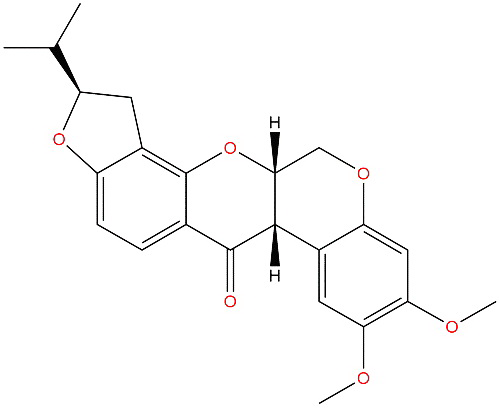
DihydrorotenoneCAS No.:6659-45-6
|
||||||||||
 |
|
|
||||||||

| Catalogue No.: | BP3939 |
| Formula: | C23H24O6 |
| Mol Weight: | 396.439 |
Product name: Dihydrorotenone
Synonym name:
Catalogue No.: BP3939
Cas No.: 6659-45-6
Formula: C23H24O6
Mol Weight: 396.439
Botanical Source:
Physical Description:
Type of Compound: Miscellaneous
Purity: 95%~99%
Analysis Method: HPLC-DAD or/and HPLC-ELSD
Identification Method: Mass, NMR
Packing: Brown vial or HDPE plastic bottle
Storage: Store in a well closed container, protected from air and light. Put into refrigerate or freeze for long term storage.
The product could be supplied from milligrams to grams
Inquire for bulk scale.
For Reference Standard and R&D, Not for Human Use Directly.
Description:
Dihydrorotenone is a potent mitochondrial inhibitor and probably induces Parkinsonian syndrome. It induces human plasma cell apoptosis by provoking endoplasmic reticulum stress and induces cell death by activating the p38 but not the JNK signaling pathway.
References:
J Biochem Mol Toxicol. 2014 May;28(5):232-8.
Natural pesticide dihydrorotenone arrests human plasma cancer cells at the G0/G1 phase of the cell cycle.
Dihydrorotenone (DHR) is a natural pesticide used for farming including organic produces. We recently found that Dihydrorotenone induces human plasma cell apoptosis by provoking endoplasmic reticulum stress.
METHODS AND RESULTS:
In the present study, we found that Dihydrorotenone arrested human plasma cancer cells at the G0/G1 phase of the cell cycle. Dihydrorotenone inhibited cyclin D2 transactivation, thus inhibiting its mRNA expression. In addition, Dihydrorotenone upregulated the cell cycle repressors p21 and p53. Dihydrorotenone also increased the phosphorylation level of p53, suggesting the upregulated transactivation function of p53, which was confirmed by the induction of p21, a substrate of activated p53. Moreover, Dihydrorotenone downregulated AKT and ERK phosphorylation, an incentive of cell cycle progression.
CONCLUSIONS:
Therefore, these results collectively demonstrated that Dihydrorotenone disrupts the cell cycle progress, which suggests that Dihydrorotenone is toxic to human plasma cells. Caution is thus suggested when handling with this agent.